Прага памятники
Пражский Град (Pražský hrad)
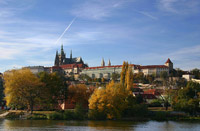
Пра́жский Град (чеш. Pražský hrad; на другие языки переводится как «крепость», нем. Prager Burg, или «за́мок», англ. Prague Castle, фр. Château de Prague) — крепость города Праги (аналог восточнославянского кремля), административный район города, резиденция президента Чехии (ранее — чешских королей, некоторых императоров Священной Римской империи, президентов Чехословакии). Самая большая по площади президентская резиденция в мире, возможно, также самый большой в мире замок.
Расположен в Градчанах на высоком холме, возвышающемся над Прагой. Исключительно богат архитектурными, …
Читать подробнее
Ка́рлов мост (Karlův most)
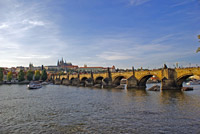
Ка́рлов мост (чеш. Karlův most) — мост в Праге через реку Влтава, соединяет районы Праги Малая Страна, и Старе Место. Построен в эпоху Средневековья. На мосту расположены 30 скульптур. Длина моста 520 м, ширина — 9,5 м. Мост опирается на 16 мощных арок, облицованных тёсаными квадрами из песчаника.
На сегодняшний день является единственным в своём роде произведением средневекового искусства. Первый камень в основание моста был заложен Карлом IV 9 июля 1357 года. Каменный мост изначально назывался Пражским, в 1870 году получил название в честь основателя.
Стратегическое значение
Мост …
Читать подробнее
Национальный музей (Národní muzeum)
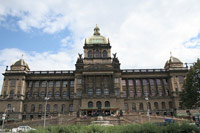
Национальный музей (чеш. Národní muzeum) — крупнейший государственный музей Праги, созданный в начале XIX века.
Главное здание
Неоренессансное здание Национального музея высотой более 70 метров и протяженностью фасада около 100 метров было построено с 1885 по 1890 год. Его автор Йозеф Шульц. Здание выходит на Вацлавскую площадь и является её архитектурной доминантой.
Монументальное здание с выразительным куполом, построенное на месте бывших Конных ворот, имеет для чешского народа особое, символическое значение. На главном фасаде здания внимание зрителя привлекает украшенная …
Читать подробнее
Национальный театр (Národní divadlo)
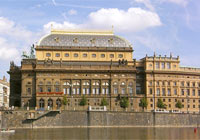
Национальный театр (чеш. Národní divadlo) — главный театр в Чехии и в Праге. Построен в 1881 году по проекту архитектора Йозефа Зитека в стиле неоренессанса, но вскоре уничтожен пожаром, воспринятым как общенародная катастрофа. После пожара был в рекордные сроки реконструирован учеником Зитека — Йозефом Шульцем, автором другого знакового сооружения — Национального музея — и с 1883 года опять открыт. Строительство велось на народные пожертвования под лозунгом «Нация — себе» (Národ sobě; эти слова украшают зрительный зал).
На северном фасаде — статуи А. Вагнера «Забоя» и «Лумира», на аттике …
Читать подробнее
Собор Святого Вита (Katedrála svatého Víta)
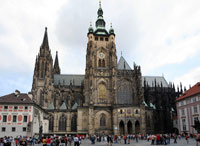
Собор Святого Вита (чеш. Katedrála svatého Víta, полное название: кафедральный собор св. Вита, Вацлава и Войтеха, Víta, Václava a Vojtěcha) — готический католический собор в Пражском Граде, местопребывание архиепископа Пражского. В соборе находится усыпальница королей Богемии и хранилище коронационных регалий.
Первый храм-ротонду на этом месте, как считается, построил ещё святой Вацлав в 925 году; церковь была посвящена святому Виту, чью десницу Вацлаву подарил восточнофранкский (германский) король Генрих I. В XI веке на месте романской ротонды была возведена трёхнефная базилика, которая …
Читать подробнее
Староместская площадь (Staroměstské náměstí)
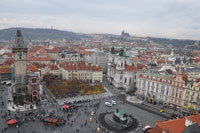
Староместская площадь (Старогородская площадь, чеш. Staroměstské náměstí) — старинная площадь Праги, расположенная в историческом центре города (Старе Место). Её площадь составляет около 15 тыс. кв. м. Площадь окружена городскими домами с фасадами различных архитектурных стилей: готического, ренессанса, барокко, рококо.
Данное место известно ещё с XII века, в то время площадь была большим рынком, стоящим на перекрестке европейских торговых путей. В XIII веке площадь стала называться Старым рынком, а с XIV века — Староместский Рынок. В XVIII веке площадь сменила несколько названий — …
Читать подробнее
Староместская ратуша (Staroměstská radnice)
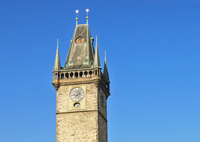
Староместская ратуша (чеш. Staroměstská radnice) в Праге была заложена в 1338 году на основании привилегии, дарованной староместским горожанам королём Яном Люксембургским. Комплекс состоит из нескольких домов, прилегающих к Староместской площади и постепенно соединённых в одно целое для нужд магистрата Пражского Старого города.
История
Основание ратуши
Исторически первым зданием был угловой раннеготический дом конца XIII века, который горожане получили от богатого купца Вольфа Камене. Доминантой дома была могучая призматическая башня, построенная в 1364 году. В 1381 году была построена …
Читать подробнее
Астрономические часы (Staroměstský orloj)
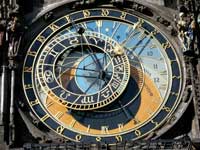
Пражские куранты, Пражский Орлой (чеш. Pražský orloj) — средневековые башенные часы, установленные на южной стене башни Староместской ратуши на Староместской площади в Праге. Часы показывают годы, месяцы, дни и часы, время восхода и захода Солнца, время восхода и захода Луны, а также положение знаков зодиака. В центре циферблата располагается Земля, вокруг которой вращается Солнце. Каждый час, когда бьют часы, происходит небольшое представление в традициях средневекового кукольного театра. Фигурки, являющиеся воплощениями человеческих пороков и таких доминант человеческой жизни, как смерть …
Читать подробнее
Государственная опера (Státní opera)
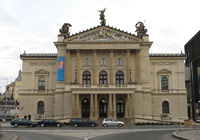
The Prague State Opera (Czech: Státní opera Praha), is an opera and ballet company in Prague, Czech Republic. The theatre was originally founded in 1888 as the New German Theatre and from 1949 to 1989 it was known as the Smetana Theatre.
History
New German Theatre
The history of the theatre currently known as the Prague State Opera dates back to the late 19th Century. While often overshadowed by the more prominent National Theatre of Prague, the company has its own distinct history. The birth of a magnificent Czech Theatre, the National Theatre, in 1883 indirectly created a longing …
Читать подробнее
Вацлавская площадь (Václavské náměstí)
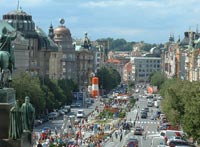
Ва́цлавская пло́щадь (чешск. Václavské náměstí), площадь святого Вацлава; разговорное название Вацлавак — Václavák) — одна из самых знаменитых и больших городских площадей в мире, главный центр Нового Места в Праге. Место многих исторических событий, традиционное место демонстраций, празднеств и общественных собраний. Торговый и деловой центр Праги, где находятся крупные отели, магазины и кафе. Площадь названа именем св. Вацлава, князя Чешского, небесного покровителя страны.
Ранее называлась Конский рынок (Koňský trh), так как в Средневековье там проводились лошадиные ярмарки. …
Читать подробнее
Валленштейнский дворец (Valdštejnský palác)
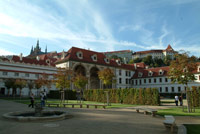
Валленштейнский дворец — крупнейший дворец Праги, место заседаний сената Чехии (с 1992 г.). Резиденция была выстроена в квартале Мала Страна для фельдмаршала Валленштейна в 1623-30 гг. на месте 26 особняков и 6 садов.
Превалирующий стиль можно определить как поздний ренессанс, или маньеризм. Строительство курировали Андреа Спецца, любимый зодчий Валленштейна, и Джованни Пьерони — ученик Галилея. Считается, что при проектировании лоджии Пьерони вдохновлялся работами своего отца в Лигурии.
Внутри дворца наиболее примечателен Рыцарский зал в два этажа с изображением Валленштейна в виде бога …
Читать подробнее
Кински дворца (Palác Kinských)
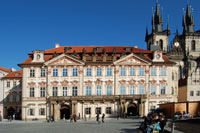
Kinsky Palace (Czech: Palác Kinských) with its beautiful pink and white stucco fasade promotes the special image of Old Town Square. It was build for Jan Arnost Goltz in 1755-65 on the place where used to stand two hotels. Goltz had the buildings rebuilt in Rococo palace with two entrances framed with two pillars. On the first floor the pillars are connected with a balcony with a balustrade.
After the death of Count Goltz, the palace was bought by Kinsky family who stayed in the palace until 1945. The palace contained a valuable family library, now it hosts collections of the National …
Читать подробнее
Общественный дом (Obecní dům)
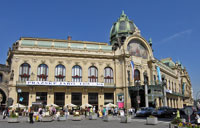
Общественный дом (чеш. Obecní dům) — здание в Праге. Расположено на Площади Республики.
Построен на месте старого королевского дворца, служившего резиденцией чешских королей в XIV—XV вв. Начат строительством в 1905 году, закончен в 1912 году. После двух неудачных конкурсов проектирование было предоставлено Освальду Поливке и Антонину Бальшанеку. В оформлении участвовали выдающиеся чешские художники: мозаичное панно на фасаде выполнено Карелом Шпилларом, другие элементы декора принадлежат Ладиславу Шалоуну, Йозефу Маржатке, Карелу Новаку и др. Над росписью интерьеров работали Альфонс Муха, …
Читать подробнее
Пороховая башня (Prašná brána)
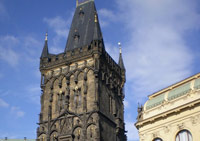
Пороховая башня или Пороховые ворота (чешск. Prašná brána — Прашна брана) находятся в Праге на Площади республики по соседству с Общественным домом и соединяется с ним крытым мостом.
История
Первый камень башни был положен в 1475 году. Ворота должны были служить одним из тринадцати входов в Старый Город, однако этому плану не суждено было сбыться. Вскоре после начала строительства король, беспокоясь о собственной безопасности, вернулся в Пражский град и старый дворец с окрестностями быстро потерял свое значение. Несмотря на богатую отделку, башня так и осталась недостроенной, позже была …
Читать подробнее
Тынский храм (Týnský chrám)
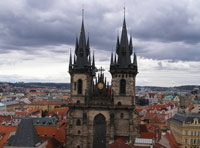
The Church of Our Lady before Týn (in Czech Kostel Matky Boží před Týnem, also Týnský chrám (Týn Church) or just Týn) is a dominant feature of the Old Town of Prague, Czech Republic, and has been the main church of this part of the city since the 14th century. The church's towers are 80 m high and topped by four small spires.
History
In the 11th century, this area was occupied by a Romanesque church, which was built there for foreign merchants coming to the near Týn Courtyard. Later it was replaced by an early Gothic Church of Our Lady in front of Týn in 1256. Construction of the …
Читать подробнее
Вифлее́мская часо́вня (Betlémská kaple)
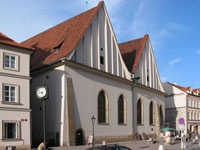
The Bethlehem Chapel (Czech: Betlémská kaple) is a medieval religious building in Prague, Czech Republic notable for its connection with the Czech reformer Jan Hus. It was opened for sermons in 1394, and taught solely in the Czech vernacular, thus breaking with German domination of the Medieval Bohemian church. The building was never officially called as a church, only a chapel.
In the 17th century, the building was acquired by the Jesuits. During reign of the Emperor Joseph II (1780s) converted into an apartment building. Under the Czechoslovakian communist regime the building was …
Читать подробнее
Каролинум (Karolinum)
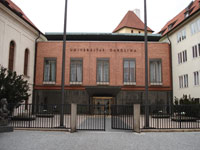
Karolinum (formerly Latin: Collegium Carolinum, in Czech Karlova kolej) is a complex of buildings located in the Old Town of the City of Prague. Karolinum, the seat of the Charles University in Prague, is one of the oldest dormitories situated in the Central Europe. The dormitory was named after the Emperor Charles IV.
History
Shortly after the establishing of Charles University in 1348, the young insititution encountered several organizational problems. One of the major complications was the lack of lecture and accommodation rooms for teachers and students. Emperor Charles IV, apparently …
Читать подробнее
Квартал (Klementinum)
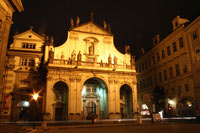
The Clementinum (Klementinum) is a historic complex of buildings in Prague. Today the complex hosts the National, University and Technical libraries, being the City Library also located nearby on Mariánské Náměstí. It is currently in use as the National Library of the Czech Republic. In 2005 the Czech National Library received the UNESCO´s Jikji prize (Memory of the World).
Its history dates from the existence of a chapel dedicated to Saint Clement in the 11th century. A Dominican monastery was founded in the medieval period, which was transformed in 1556 to a Jesuit college. In 1622 the …
Читать подробнее
Рудольфинум (Rudolfinum)
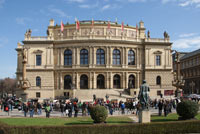
The Rudolfinum is a music auditorium in Prague, Czech Republic. It is one of the most important neo-renaissance buildings in the city and is situated at Jan Palach Square on the bank of the river Vltava.
Since 1946 the Rudolfinum has been the home-stage of the Czech Philharmonic Orchestra and one of the main venues performed in the Dvořák Hall for the Prague Spring International Music Festival held each year in May and June. The building was designed by architect Josef Zítek and his student Josef Schulz, and was opened February 8, 1885. It is named in honour of Rudolf, Crown Prince of …
Читать подробнее
Jindřišská башня (Jindřišská věž)
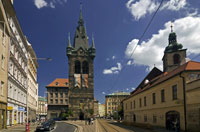
The Jindrisska Tower is a historic bell tower, first built in the 15th century. Renovated in 2001 the tower now features a restaurant and a 10th floor lookout where you have great views over the city.
History
At 65.7 meter (216 ft), the Jindrisska Tower is the tallest free-standing bell tower in Prague. Its history goes back to 1475 when it was built in wood as the bell tower of the Church of St. Henry and Kunhuta (kostel sv Jindrich a Kunhuty), the parish church of New Town.
The current stone version was built at the end of the 16th century. The tower was damaged several times, first …
Читать подробнее
Базилика Святого Георгия (Bazilika svatého Jiří)
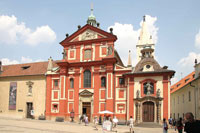
St. George's Basilica (Czech: Bazilika Sv. Jiří) is the oldest surviving church building within Prague Castle, Prague, Czech Republic. The basilica was founded by Vratislaus I of Bohemia in 920. It is dedicated to Saint George.
The basilica was substantially enlarged in 973 with the addition of the Benedictine St. George's Abbey. It was rebuilt following a major fire in 1142. The Baroque façade dates from the late 17th century. A Gothic style chapel dedicated to Ludmila of Bohemia holds the tomb of the saint. The shrines of Vratislav and Boleslaus II of Bohemia are also in the basilica. …
Читать подробнее
Церковь Св. Николая Чудотворца (Kostel svatého Mikuláše)
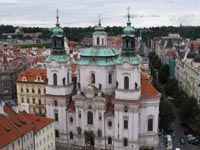
Though smaller and not as rich as the Cathedral of St. Nicholas from the Lesser Town, The Church of St. Nicholas in the Old Town Square plenty deserves its place among Prague’s most appreciated and visited places. If you just think about the eight centuries that it has stood and faced the wickedness of the history you come to look at it in a totally different way.
History
Historical sources mention this place of worship as early as 1273, originally as a parish church, where Hussitism and Reformation used to be preached. Later in the 17th century the church fell into Benedictine …
Читать подробнее
Церковь Св. Николая (Chrám svatého Mikuláše)
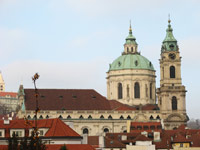
St. Nicholas Church (Cathedral) (Chrám svatého Mikuláše) from the Lesser Quarter in Prague has put its name into Czech and European Baroque era and is now Prague number one church of this kind. Its history is linked to Czech re-catholisation process that followed the defeat of the Hussites in the Battle of the White Mountain (1620).
The beginnings of the imposing Cathedral that we see today go back to the year 1283, when the place of worship started its existence as a parish church under the name and protection of St. Nicholas. With the change of authority in the 17th century, Baroque era …
Читать подробнее
Черная башня (Černá věž)
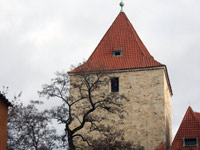
The Black Tower is one of the oldest existing buildings in Prague. It was built in 1135 as an eastern gate of the Romanesque fortification of Prague Castle. You can still see the former gateway on the ground floor, but it is walled up now.
Origin of the name "Black Tower"
The Black Tower belongs to the area of the Supreme Burgrave's House at Prague Castle. Its name "Black" originates from the time of the big fire of Prague Castle in 1541 - its walls remained black for a long time.
However, the tower was called "Golden" in the era of Emperor Charles IV in the 14th century because of its …
Читать подробнее
vyshegrad (Vyšehrad)
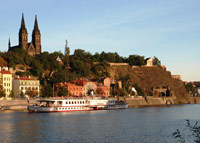
Vysehrad is a castle located in the city of Prague, Czech Republic. It was probably built in the 10th century, on a hill over the Vltava River. Situated within the castle is the Basilica of St Peter and St Paul, as well as the Vysehrad Cemetery, containing the remains of many famous people from the Czech history, among them Antonín Dvořák, Bedřich Smetana and Karel Čapek.
Local legend holds that Vysehrad was the location of the first settlement which would later become Prague, though thus far this claim remains unsubstantiated.
History
When the Přemyslid dynasty settled on the current …
Читать подробнее
Церковь Богоматери Победы (Kostel panny Marie Vítězné)
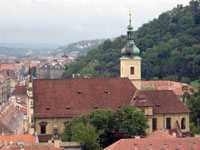
The Church of Our Lady Victorious (Czech: Kostel Panny Marie Vítězné) in Malá Strana, the "small side" of Prague is a Carmelite church and the home of the statue called the "Infant Jesus of Prague".
A chapel dedicated to the Holy Trinity was built on this site in 1584. With the Battle of White Mountain, 8 November 1620, the Counter-Reformation signalled the re-Catholicisation of Prague. The church was given to the direction of the Carmelites in September 1624. The triumphalist altarpiece of Our Lady of Victory was sent from Rome by Pope Gregory XV. The Carmelites were ordered to hand over …
Читать подробнее
Малая площадь (Malostranské náměstí)
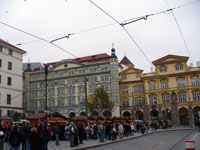
Since it was laid out in 1257, this square has been the heart of Lesser Town (Czech: Malá Strana), a district situated at the foot of the Prague Castle. The square is dominated by St. Nicholas Church, a impressive baroque church that occupies the center of the square.
Magnificent houses with Renaissance and Baroque façades border Lesser Town Square (Czech: Malostranské náměstí) on all sides. During the Middle Ages, when the square was the site of a market for the Prague Castle, the buildings had Gothic designs. A fire that broke out at the square destroyed most of the houses and they were …
Читать подробнее
Петрин (Petřín)
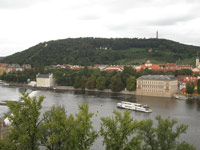
Petřín (327 m) is a hill in the center of Prague, Czech Republic. It rises some 130 m above the left bank of the Vltava River. The hill, almost entirely covered with parks, is a favorite recreational area for the inhabitants of Prague. The hill (in German known as Laurenziberg) is featured prominently in Franz Kafka's early short story "Description of a Struggle" and briefly in Milan Kundera's novel The Unbearable Lightness of Being.
The summit of the hill is linked to Prague's Malá Strana district by the Petřín funicular, a funicular railway that first operated in 1891.
Читать подробнее
Оператора
- Телефон: +420 261 264 369
- E-mail: info@arcadira.eu
Туристические информации
Tourist Information about Prague and Czech republic. History, Culture, Language, Currency, Visa and much more.
Лист гостинниц в Праге
Прага 3* гостинницы
- Botel Albatros
- Botel Florentina
- Botel Racek
- Hotel Ankora
- Hotel Arbes - Mepro
- Hotel Atos
- Hotel Donatello
- Hotel Globus
- Hotel Gloria
- Hotel ILF
- Hotel Legie
- Hotel Old Prague
- Hotel Olsanka
- Hotel Olympik Tristar
- Hotel Victoria
- King George´s House
Прага 4* гостинницы
- Hotel Adria
- Hotel Amigo
- Hotel Arkada
- Hotel Barceló
- Hotel Barceló Old Town
- Hotel Caesar Palace
- Hotel Corinthia Panorama
- Hotel Golf
- Hotel Holiday Inn Congress Centre
- Hotel Louis Leger
- Hotel Majestic Plaza
- Hotel Olympik
- Hotel Pyramida
- Hotel Roma
- Hotel Step
- Hotel U Krále Karla
- Hotel U Páva
- Hotel Yasmin
Прага 5* гостинницы
Контакты
- Pragap Tour, s.r.o. (Arcadira)
- Liliová 10
- 110 00, Praha 1
- Česká republika
- Номер телефона: +420 261 264 369
- Номер факса: +420 244 400 157
- Е-mail: info@arcadira.eu
- Facebook: www.facebook.com
- ICO: 25147412
- DIC: CZ25147412
© 2008-2024 Pragap Tour, s r.o. (Arcadira) | Все права защищены | Коммерческие условия | Created by Jaroslav Salivar